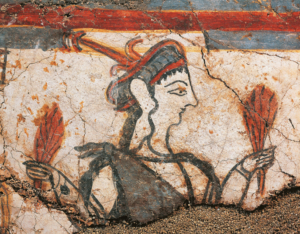It is enough to imagine those proud warriors, the ancestors of Agamemnon, dominating the Iron and Bronze Ages in imposing citadels with complex entrance systems, entering magnificent palaces, like those described characteristically by Homer in the Iliad. Like that “bronze-clad” and proud Agamemnon, the Mycenaeans were considered invincible warriors, dominating the Mediterranean, the best in trade and battle.
We imagine the well-groomed king sitting on his throne, wearing his fine tunic, organizing banquets, which were customary at that time in enormous halls, with walls decorated with beautiful frescoes of war scenes, like those later imitated by the Macedonians.
The myth does not accidentally have the son of Zeus, Perseus, after he killed the terrible Medusa, arriving at Mycenae and seeing a hill at the foot of which the entire sea stretches, as Apollodorus once mentioned, and calling upon the Cyclopes to build impregnable walls, the famous Cyclopean walls. After all, the first and fearless king of Mycenae, the famous Agamemnon, was a descendant of Atreus.
Although it is a myth, it is not coincidentally connected with real figures, kings, and rulers who dominated Greece during the Bronze Age, when the wealthy Mycenaeans prevailed across the Mediterranean, plowing the seas and spreading their ways and traditions to various centers.
Although the Mycenaean civilization is directly associated with the world of the Iliad and dominant myths, it was inspired by the one that truly radiated across a vast empire, from Asia Minor and the Near East to Northwestern Europe from 1600 to 1100 BC – although the Greek-speaking Achaeans seem to have settled in the Greek region around 2000 BC. They were the ones who built palaces, strong Cyclopean walls, and established administrative, military, economic, and religious centers in dominant cities, setting up settlements around their Acropolises.
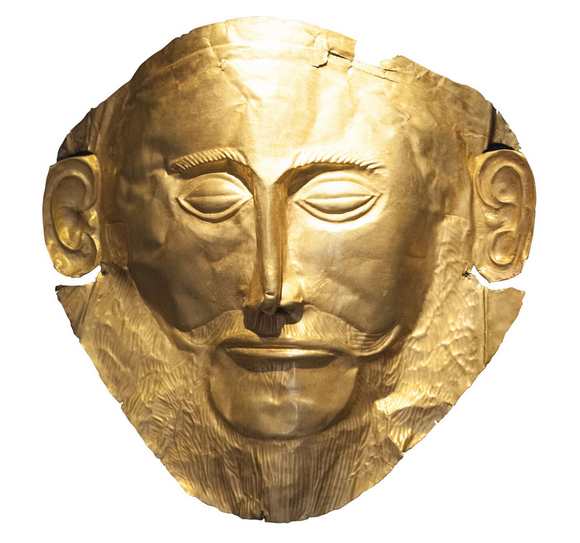
Even today, their characteristic tombs with the rich finds, golden accessories, garments, and impressive swords still impress. As soon as you enter, for example, the characteristic Hall 4 at the National Archaeological Museum, you are dazzled, almost blinded by the shine of gold. Ritual vessels, books with embossed decoration, masterpiece seal rings, and numerous bronze weapons from unforgettable leadership figures leave no doubt about who the rulers of the Greek world were back then.
The eye automatically falls on that golden mask covering the face of some king – the famous mask of Agamemnon – with the tight lips showing determination and strength, even though it is a funerary mask. It is these very features that made Schliemann exclaim, when he discovered it, that this is Agamemnon!
The eye also automatically falls on the beautiful Mycenaean amphorae, with huge octopuses embracing the vessel in a seascape of rocks and seaweed, and one cannot help but think how similar all these Mediterranean civilizations are. I imagine some artisan being inspired by the marine motifs of the Minoans so many centuries before and trying to surpass them in beauty and refinement, just like now.
The Story of the Vessels
A Mycenaean ruler from the so-called Dark Ages (11th-9th century BC) had been seen starring in one of the exhibitions of the “Invisible Museum,” where treasures from the storage rooms of the National Archaeological Museum or objects that had not been exhibited until then were selected, revealing many unknown stories.
Especially the story of the lord from Lefkandi had captured attention, as it hid many secrets besides his “garment” which we had seen exhibited in 2019. Now, following that exhibition, we see the highly interesting exhibition on the “Mycenaean Alchemists,” which reveals a lot about how people of the time acted in relation to burial customs – and more.

The path and scenarios for the history around these specific objects that are exhibited, as well as the entire concept of the “Invisible Museum” in the Altar Hall, are revealed by the curator of antiquities, Dr. Kostas Paschalidis. “The truth is that the whole group of tin-plated items is a dark example, as research has focused on studying their preparation and usability,” he tells us about these objects, which were covered with thin sheets of tin to give the impression that they were made of gold, with the purpose of accompanying the dead on their final journey, thus serving not only as symposium vessels but also as grave goods.
It is precisely this use that seems to have caught Mr. Paschalidis’s interest, leading him to think that the story of their “second” life, after the tin sheets transformed them into something more than just utilitarian objects, brings to the surface alchemical methods. “What interested me was the need that drove the people of that time to carry out such an act, meaning what significance this offering had and what magical implications it might conceal,” he emphasizes, explaining the title of the exhibition.
It is enough to imagine Mycenaeans of middle social status essentially mimicking the rituals of the nobility, who ensured the maximum possible luxury for their burial, wrapping different vessels with tin sheets that made them resemble gold. In fact, just an animal glue was enough to perfectly cover the entire surface, and thin sheets of tin (which would resemble today’s aluminum foil) were used to give the impression that the vessels were silver.
“Exactly because they did not have the means to offer the dead silver or gold vessels, they offered whatever they had from their possessions to the deceased – even though they knew that tin does not withstand difficult weather conditions and deteriorates,” Mr. Paschalidis explains to us, something that automatically makes their gesture a noble one.
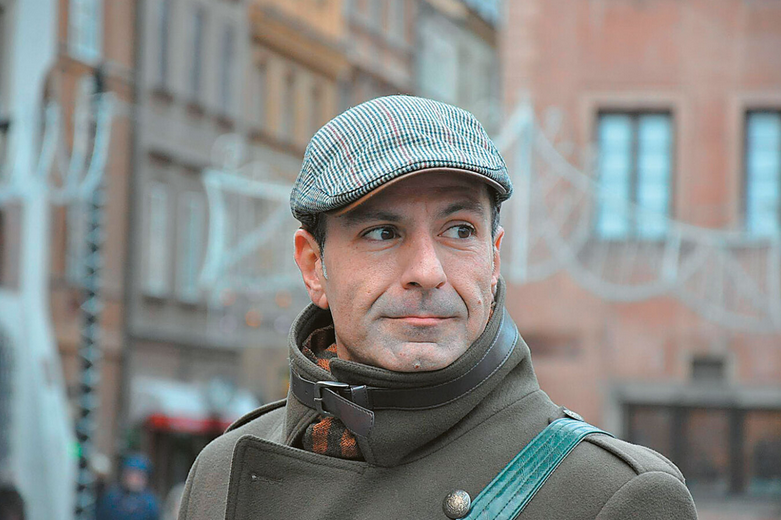
“There is the so-called ‘tin disease,’ which is the change in its crystalline structure that occurs at temperatures below 13 degrees, meaning that just prolonged humidity is enough to turn the material into powder, and those who made these objects knew this very well. In other words, they knew that if they opened the tomb, everything would be altered. But why did they insist on making this gesture? This is a starting point for us, to examine this phenomenon, to see what gave birth to the need to give these objects a second life. In my opinion, it is a semblance of nobility of the metal, but also a semblance of immortality.”
The Mycenaean Symposia
All of this took place with vessels intended for daily use, that is, symposium vessels which were later tin-plated to look like gold or silver.
“It is enough to consider the importance that the symposium had for the Mycenaean world, since it concerned the elite and the recognized men, all those who were destined to form, through conversations, agreements, and alliances. This is the well-known logic we encounter in Homer, ‘Sit down, let me treat you, tell me who you are, and let’s form bonds of honor and friendship.’ In other words, it is the contract of friendship and bonds between strangers, or the renewal of it, which, combined with the use of metals – because we have golden and silver cups at that time – reveals how close the bonds were in relation to a specific environment. In other words, the first act is the drinking, so the bonds, and then follows the burial, the ‘dance’ of death.”
However, as Mr. Paschalidis points out, the interesting thing is that those offering the tin-plated items are fully aware that they will decompose along with the body of the deceased. “In short, at the final farewell, there is the symposium and a body scented, painted, and dressed in its finest clothes. The decomposition of the tin-plating will happen along with the decomposition of the dead. But the image that the one offering them has, as they bid farewell publicly, is that the beloved person will now sleep in the tomb and have with them valuable vessels, tools, supplies, and everything needed.”

Why Alchemists?
In response to the question of why the “Invisible Museum” exhibition talks about Mycenaean Alchemists, the answer inevitably involves the entire historical phenomenon of alchemy, as a process that, in addition to its craftsmanship aspect, also has a sacred dimension. So many stories have been written about the alchemists of the Hellenistic world, such as those of Alexandria, who uniquely combined science with mysticism, up to those of the Middle Ages and the Renaissance, and the Da Vinci code.
“In reality, Alchemists seek the way to turn materials into gold, as well as the elixir of life and immortality, the so-called panacea,” comments Mr. Paschalidis on the matter.
“It’s no coincidence that we see their methods being adopted much later, at least in terms of the symbolism, by psychoanalysts, even though it is clear that the concept and perspective of alchemy evolved over the centuries. It took one direction in the Hellenistic period and another in the Middle Ages. What concerned us regarding this particular exhibition, however, is a question that doesn’t require you to be an alchemist to understand deeply: that people must die when they want to, and never at any other time. Therefore, the goal is to find a way to stay young and prevent decay. You also want to turn something that deteriorates into something that does not. Thus, on the tactile level of metals, gold is not only precious economically, but it is precious because it transcends the limits of life: it lives much longer than we do. For example, you know that your gold baptismal cross can pass through the hands of many generations precisely because it transcends the limits of life and can carry your imprint through the centuries. In short, you realize that, to the extent that it lives longer than you, it possesses enormous power. So, to the extent that people seek to transform matter into something noble and immortal, we are talking about something that remains undifferentiated over the course of the centuries. We all get angry with decay and death, and we all would like to extend things for our loved ones or for ourselves, whether practically or symbolically, and for these things to remain unchanged like gold. Therefore, I don’t think the Mycenaeans did anything more than respond to humanity’s basic fear. That’s why I respect them, because they organize the ceremony of death as a grand feast, where everyone drinks together, and they transform this shared experience into something everlasting that is silver and gold.”

Thus, as a scientist and curator of these particular exhibits, he dares to go a step further than where the literature stops, advocating that the reasons behind the Mycenaeans giving a second life to these objects were not only aesthetic – it was something more than that. It was the inner need they felt to conquer a fictitious eternity, standing on the threshold of death.
“But again, we are talking about conjectures, not certainties,” Mr. Paschalidis emphasizes, explaining the different depictions of the metaphysical, the deities they believed in, and the relationship they presumably had with metaphysics or the Afterlife. “Usually, in the various depictions, demons or significant female figures are shown receiving gifts and participating in invocations. It was common in the Mycenaean world for women to be high priests, and thus the ideal mediators between the divine and the human.” My mind immediately goes, without saying it, to that mythical female figure of Aerope, who gives the golden ram of Atreus to Thyestes, the father of Agamemnon and Menelaus, hence the tragedy of Euripides “Atreus or Mycenae,” another proof of the dominant role of women in the Mycenaean world. “The Mycenaeans wake up in the 16th century BC with an unimaginable wealth at their disposal, which we don’t know the origin of. They must find new ways because they descended from poor ancestors, and the nearest place from which to obtain valuable vessels and behaviors is Minoan Crete. Hence, they borrow many elements from Crete, but these do not make them Cretans, nor do they appear to adopt any religion that makes them something they are not. They simply learn.”
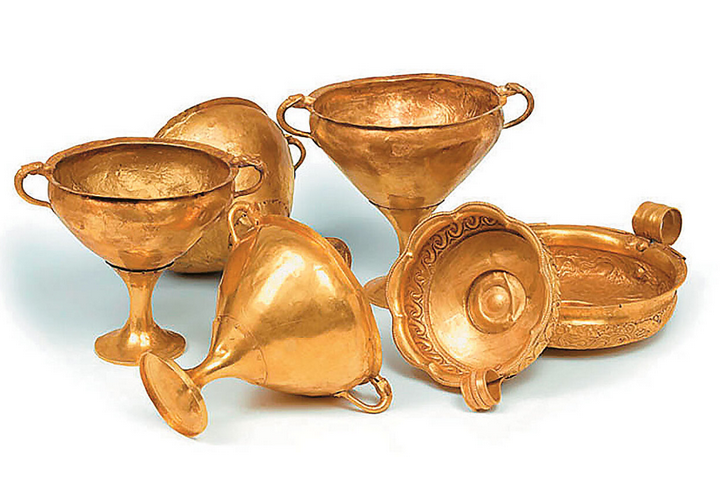
Linear B
In other words, what the Mycenaeans essentially do is adopt foreign methods and bring in craftsmen for their own emblematic works, copying the Minoans in several ways, such as with their beautiful seals or exquisite frescoes. “But they believe in their own tradition and fear their own spirits,” adds Mr. Paschalidis. “And we know this because they bury their dead in their own way, following the traditions of their ancestors. Because the last thing you would change is your belief in what follows you and what awaits you. The moment of fear reveals your true origins—the ‘who you are from’ as we used to say in the villages.”
Therefore, when later the Minoan world goes through a major crisis, especially after the eruption of the Santorini volcano, the Mycenaeans intervene with force, conquer part of the island, and establish their own territory.
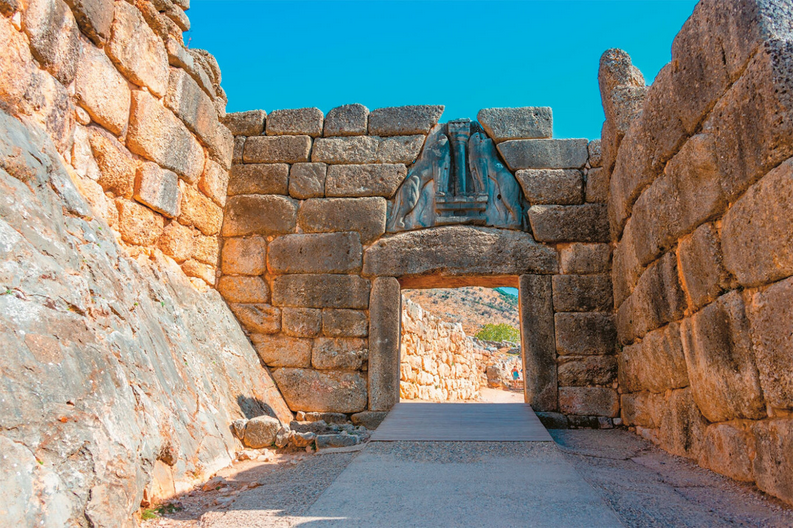
“In reality, the Mycenaeans went through something similar to what the later Romans experienced, who conquered and were conquered, although they gave much to the Cretans, such as their burial customs. Earlier, they had copied them in writing because they were forced to write in order to remember. They write in Linear B, but with differences. However, what happens with these specific burial customs and these grave goods does not happen anywhere else other than in the world of the Mycenaeans—that is, the epikassitērōsis (the practice of gilding pottery) and the attribution of the shine of silver and gold, which gave an appearance of immortality for the needs of Mycenaean theology of death,” concludes Mr. Paschalidis.
Ask me anything
Explore related questions
